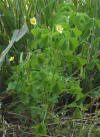WILD
FOODIES' HOME PAGE
PLANT PROFILE LIST
NAME: Wood Sorrel
SPECIES / FAMILY: Oxalis Stricta / Oxalidaceae
OTHER COMMON NAME(S): Yellow Wood Sorrel
CONDITIONS:
partial shade
|
PARTS: |
EDIBLE |
TASTE |
RAW/COOK |
SEASON |
|
All |
|
|
|
|
|
Shoots |
|
|
|
|
|
Leaves |
|
lemony-tart |
RAW/COOK |
Summer-Fall |
|
Buds/Flowers |
|
lemony-tart |
RAW/COOK |
Summer-Fall |
|
Fruits |
|
|
|
|
|
Roots |
|
|||
|
Seed Pod |
|
lemony-tart |
RAW/COOK | Summer-Fall |
|
Nuts |
|
|
|
|
|
Pods |
|
|
|
|
|
Stalk |
|
|
|
|
|
Bark |
|
|
|
|
PORTION: very small, herb
COMMENT: This is a great herb for the beginner. Tastes tart and lemony. Heart-shaped leaves. Great compliment to fish dishes, in smoothies, as a garnish and a nibble. Leaves - add to salads, cooked as a potherb with other milder flavoured greens or used to give a sour flavour to other foods. The leaves are available all year round unless the winter is very cold, they have a pleasantly sour taste. Flowers - raw. A nice acid flavour and a pleasant addition to the salad bowl.
CAUTION: Contains oxalic acid, to minimize cook with lid off.// The leaves contain oxalic acid, which gives them their sharp flavour. Perfectly all right in small quantities, the leaves should not be eaten in large amounts since oxalic acid can bind up the body's supply of calcium leading to nutritional deficiency. The quantity of oxalic acid will be reduced if the leaves are cooked. People with a tendency to rheumatism, arthritis, gout, kidney stones or hyperacidity should take especial caution if including this plant in their diet since it can aggravate their condition (1)
NUTRITION/MEDICINAL: The leaves contain about 86% water, 2.3% protein, 0.8% fat, 8.2% carbohydrate, 150mg calcium, 78mg phosphorus, 8mg iron, 0.6mg niacin, 78mg vitamin C, 6050µg beta carotene. Vitamin A & C (4) An infusion of the plant has been used in the treatment of fevers, stomach cramps and nausea. A poultice of the plant has been used to treat swellings. (1) Note: Creeping Wood Sorrel seems to have many more health benefits, which makes one wonder about the research disparity between the two species - https://pfaf.org/user/plant.aspx?LatinName=Oxalis+corniculata
LOOK-A-LIKES: Wood Sorrel’s leaflets are heart-shaped, not oval as in Clovers,
POISONOUS LOOK-A-LIKES:
OTHER USES: A yellow to orange dye can be obtained by boiling up the whole plant.(1)
SOURCE LINKS (may include nutritional and medicinal info, plus other uses):
- https://pfaf.org/user/Plant.aspx?LatinName=Oxalis+stricta
- http://www.eattheweeds.com/?s=wood+sorrel
- https://en.wikipedia.org/wiki/Oxalis_stricta
- https://commons.wikimedia.org/wiki/Oxalis_stricta (good photos)
- http://www.foragingtexas.com/2008/08/wood-sorel.html (good photos)
- https://www.wildedible.com/wild-food-guide/wood-sorrel
- https://www.ediblewildfood.com/wood-sorrel.aspx
- https://www.healthygreensavvy.com/wood-sorrel-sour-grass-edible
- https://practicalselfreliance.com/wood-sorrel
- https://feralforaging.com/wood-sorrel
- https://foraging.sycamore.garden/plants/edible-wild-wood-sorrel
- https://dengarden.com/gardening/oxalis
- https://discover.texasrealfood.com/wild-edible-plants/wood-sorrel
- https://www.fourseasonforaging.com/blog/2021/1/5/yellow-wood-sorrel-small-plant-big-taste
- https://britishlocalfood.com/wood-sorrel


